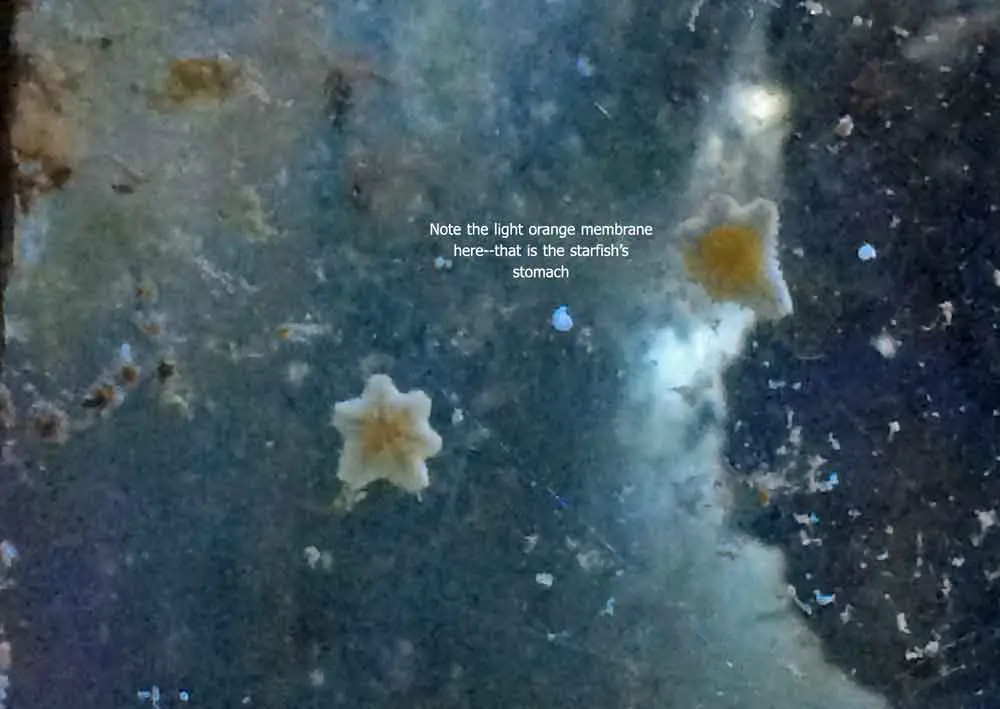Hitchhiker Starfish ID Please
Do you have these starfish growing in your tank? I do. They are called Asterina Starfish.
 They are tiny starfish that grow up to be about a quarter of an inch to an inch across (Sprung 2001)—which I found out, through painstaking scientific examination, is approximately the same size as George Washington’s face on a quarter (Ulrich…being a knucklehead moments ago).
They are tiny starfish that grow up to be about a quarter of an inch to an inch across (Sprung 2001)—which I found out, through painstaking scientific examination, is approximately the same size as George Washington’s face on a quarter (Ulrich…being a knucklehead moments ago).

I typically notice them munching on algae on my aquarium glass, especially when the glass is dirty. I’m not sure if that’s when they are most active, or if that’s when I feel the most guilt for cleaning the glass.
How do I know they’re munching away? Starfish eat by extending their stomachs outside of a central cavity on the underside of their body. You can see this in action on the aquarium glass, where the soft, translucent stomach can be seen as a salmon color between the glass and the hard shell of the starfish.
In my tank, these starfish tend to be missing legs. It is rare to find them with what you may be thinking of asymmetrical. I learned that, like corals, these starfish reproduce from fragments of themselves, by a process called fission.
The big question is: are these starfish reef safe?
Are these starfish reef safe?
Whether or not these Asterina starfish are reef safe appears to be a more complicated question than you would think.
Julian Sprung, in Invertebrates, mentions that the smaller species feed on algae, but other larger species may sometimes feed on coral tissue and are considered to be dangerous in the reef aquarium, because they might feed on coral tissue and because they reproduce rapidly.
However, there appears to be a bit of an air of mystery about these starfish. There are plenty of forum threads about these little critters—and most of what I see online is people talking about proactively removing them from their tanks, in fear that these little critters will be coral predators—but I have seen very little proof of these critters in action.
Even in the Sprung book, there is an image of some Asterina starfish munching on an obviously dying stony coral, but the coral is hundreds of times larger than the Asterina starfish allegedly caught in the act of murder, but the entire coral mass has bleached…not just the parts the starfish have eaten. Which begs the question of whether the starfish were attracted to the dying coral or whether the starfish caused the demise of the coral.
There was a report of these critters causing problems (eating) at the base of SPS corals on GARF.org.

Asterina starfish are also thought to eat soft coral polyps, like green star polyps. I have kept green star polyps for years—and have yet to see anything stunt their growth, besides the air. The Asterina in my tank are always on the glass, never on the GSP, or zoanthids, for that matter.
Like the Aiptasia anemone, I think the Asterina starfish has a bad rap. Over the years, I have had a few different species (or at least color morphs) in my tank, and I’ve never noticed any problems.
Starfish are opportunistic eaters, I have no doubts about that—and in an immaculately cleaned tank, I can see a starfish resorting to whatever food source is available, but I have a hard time believing these little guys should be extinguished, en masse, if you don’t see them causing any problems.
With that said, if you have had personal, first-hand experience with asterina starfish causing problems, I encourage you to reply to this post and let us know. I will personally continue to watch these starfish with one suspiciously raised eyebrow, but for now, I am pronouncing them harmless…you know what…I’m going to elevate their status from harmless to helpful…since they appear to be cleaning up the aquarium glass, one George Washington face-full at a time. For that reason, I plan to live and let live



Leave a Reply